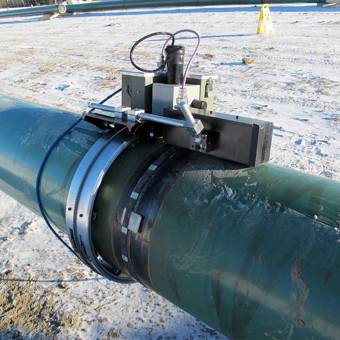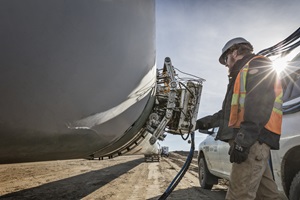Detailed Pipeline Welding Inspection Solutions for Professional Projects
Detailed Pipeline Welding Inspection Solutions for Professional Projects
Blog Article
Making Best Use Of Performance: Pipe Welding Inspection Best Practices
In the world of pipe construction, the honesty and safety of welded joints are vital. Guaranteeing that welding inspections are conducted successfully and properly can significantly impact the general high quality of the task. By executing finest methods for pipeline welding assessment, organizations can streamline procedures, decrease mistakes, and improve project timelines. From utilizing advanced modern technology to establishing rigid inspection procedures, there are many techniques that can be employed to take full advantage of performance in this important facet of pipe building - Pipeline Welding Inspection. The meticulous focus to information called for in welding evaluation holds the crucial to the long-term toughness and dependability of the pipelines, making it a topic of utmost significance in the industry.

Relevance of Efficient Welding Assessments
Reliable welding assessments play a crucial role in making sure the structural honesty and safety of pipes. Proper examinations are important to identify any type of issues, stoppages, or imperfections in the welded joints that could compromise the overall integrity of the pipeline system. By conducting extensive assessments, examiners can find problems beforehand, protecting against possible leakages, ruptures, or failures that could have significant ecological and safety and security effects.
Prompt and precise welding examinations also help in keeping compliance with sector requirements and laws. Following these criteria is not just a legal requirement but additionally a necessary step to guarantee the dependability and longevity of the pipelines. Furthermore, efficient assessments can add to set you back savings by decreasing the requirement for expensive repairs or substitutes as a result of welding flaws that could have been protected against or remedied during the evaluation procedure.
Using Innovation for Evaluations
To improve the efficiency and precision of pipeline welding assessments, the integration of advanced innovations has actually come to be progressively imperative in ensuring accurate and thorough analyses of welded joints. Making use of technology for inspections supplies various benefits, including increased effectiveness, enhanced accuracy, and enhanced precaution. Among the essential technological improvements in pipe welding assessments is using automated ultrasonic screening (AUT) systems. These systems can scan welds promptly and precisely, providing in-depth information on prospective issues or concerns within the weld joint. In addition, remote aesthetic evaluation (RVI) devices such as robotic crawlers furnished with cameras allow inspectors to accessibility and evaluate difficult-to-reach areas without the need for substantial disassembly or hands-on intervention. Moreover, the application of electronic systems for data evaluation and reporting enhances the assessment process, enabling real-time information analysis and smooth documentation. By accepting these technical services, pipeline welding inspections can be conducted better, leading to better welds, boosted general security, and minimized task timelines.
Developing Clear Assessment Protocols
Establishing clear inspection protocols is important for ensuring uniformity and integrity in the pipe welding inspection procedure. These methods serve as a set of standards that lay out the particular steps, requirements, and approaches to be followed during assessments. By plainly specifying the inspection procedures, all examiners associated with the procedure can understand their functions and obligations, leading to a much more standard and effective inspection workflow.

Normal evaluation and updates to the examination methods are also important to adjust to changing industry requirements and needs. By continuously refining and enhancing the procedures based upon responses and lessons learned, pipeline welding evaluations can maintain the greatest top quality criteria and governing conformity.
Training and Qualifications for Assessors
Educating and certifications for examiners are critical in ensuring the proficiency and effectiveness of individuals tasked with looking after pipeline welding processes - Pipeline Welding Inspection. Appropriately trained assessors possess the necessary expertise and skills to effectively examine weld high quality, adherence to welding procedures, and conformity with market standards and guidelines
Certifications, such as those supplied by the American Welding Society (AWS) or the American Oil Institute (API), verify an assessor's expertise and capability to perform assessments to the highest requirements. These certifications commonly require extensive training, examinations, and continuous specialist advancement to make certain that inspectors remain current with the current improvements in Recommended Reading welding technology and examination methods.
In enhancement to formal certifications, continual training programs play a critical duty in improving assessors' capacities. These programs cover a wide variety of subjects, including welding processes, problem discovery, safety protocols, and relevant codes and standards (Pipeline Welding Inspection). By buying extensive training and accreditations for examiners, companies can support the stability of their pipe welding tasks and mitigate the risks connected with substandard welds
Continuous Improvement in Evaluation Processes
Building upon the foundation of licensed and skilled assessors, continual improvement in evaluation processes is important for making sure the continuous high quality and compliance of pipeline welding operations. By implementing a system of continual renovation, pipe welding assessment procedures can progress to satisfy the altering demands of the industry, technological advancements, and regulatory needs. This entails consistently examining and evaluating evaluation devices, techniques, and treatments to identify locations for enhancement.
One key facet of constant improvement in inspection procedures is comments. Gathering input from assessors, welders, designers, and other stakeholders permits for a thorough evaluation of current practices and the recognition of possible areas for enhancement. Additionally, leveraging information and analytics can supply useful insights right into the efficiency of evaluation procedures, enabling educated decision-making for optimization.
Additionally, spending in training and advancement programs for assessors can guarantee that informative post they are outfitted with the most recent expertise and skills to do their responsibilities effectively. Continuous enhancement is a vibrant process that needs devotion and commitment from all stakeholders to drive excellence in pipe welding inspection methods.
Verdict
In final thought, optimizing effectiveness in pipeline welding examinations is vital for making certain the high quality and security of infrastructure tasks. By using modern technology, developing clear protocols, giving appropriate training and certifications for assessors, and continuously boosting evaluation procedures, organizations can simplify their operations and decrease dangers. It is great site important for sectors to prioritize reliable welding assessments to maintain high requirements and fulfill regulative needs.
Efficient examinations can contribute to set you back financial savings by reducing the demand for pricey repairs or substitutes due to welding problems that could have been stopped or fixed throughout the examination procedure.
Establishing clear inspection methods is essential for making certain consistency and integrity in the pipe welding inspection process. By plainly specifying the inspection procedures, all examiners entailed in the procedure can understand their duties and duties, leading to a more standardized and effective inspection workflow.
Clear evaluation procedures assist in lowering the likelihood of errors or oversights during the evaluation procedure.Structure upon the structure of experienced and qualified examiners, continual renovation in inspection processes is essential for making sure the recurring top quality and compliance of pipeline welding operations.
Report this page